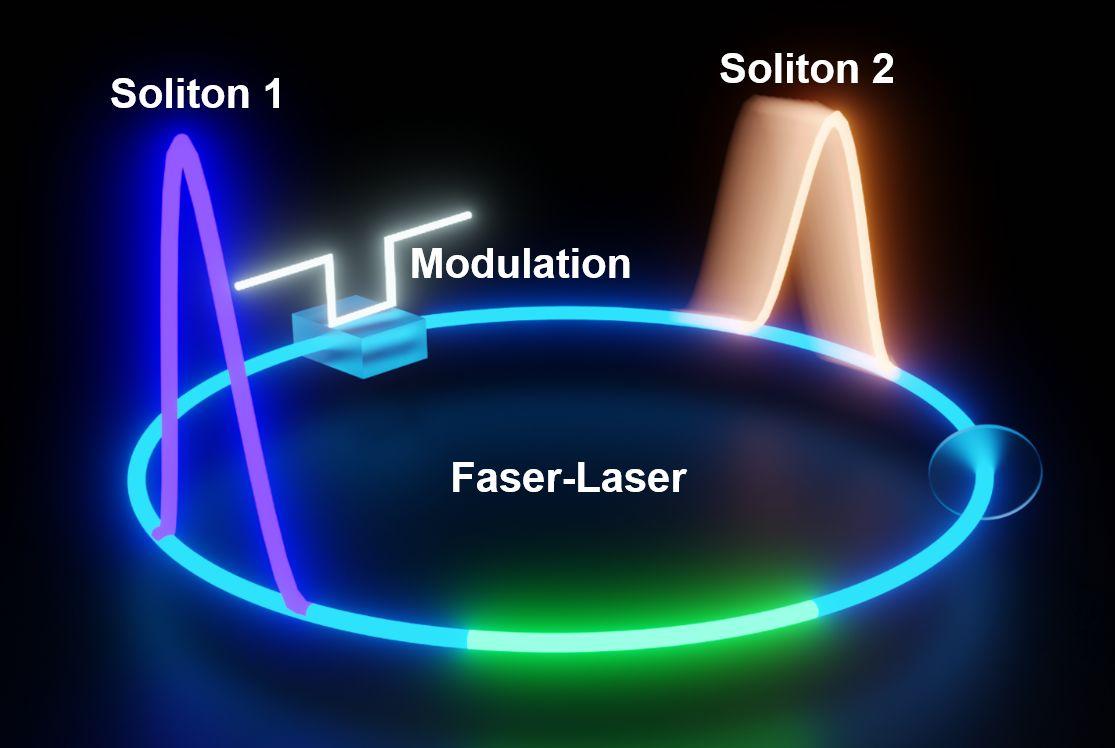Ultra-short laser flashes on demand: controllable light pulse pairs from a single fibre laser
University of Bayreuth, Press release No. 002/2024, 11 January 2024
In an innovative approach to controlling ultrashort laser flashes, researchers from the Universities of Bayreuth and Konstanz are using soliton physics and two pulse combs within a single laser. The method has the potential to drastically speed up and simplify laser applications. The results of the research have now been published in Science Advances.
What for?
The timing in the sequence of ultrashort laser pulses is crucial for a wide range of laser applications from material analysis to precision machining. The current work by Prof. Dr Georg Herink and his doctoral student Julia A. Lang from the University of Bayreuth and their colleagues from the University of Konstanz demonstrates for the first time a new method for the rapid generation of pulse sequences with freely tunable timing based on a compact fibre laser - and free of any mechanics. The results are important for accelerating short-pulse-based microscopy and spectroscopy methods.
Traditionally, the pulse spacing of lasers is set by splitting each pulse into two pulses and delaying them over different, mechanically tunable distances. Alternatively, two laser sources with slightly different orbital periods ("dual combs") are used to generate fast travelling delays from the superposition of the two pulse combs. The purely optical method demonstrated by Prof Dr Georg Herink, head of the group "Experimental Physics VIII - Ultrafast Dynamics" at the University of Bayreuth and his doctoral student Julia A. Lang in cooperation with Prof Dr Alfred Leitenstorfer and Sarah R. Hutter from the University of Konstanz is based on two pulse combs within a single laser. It enables extremely fast and flexibly adjustable pulse sequences. At the same time, this can be implemented in very compact, glass fibre-based light sources. By temporally merging the two pulse combs outside the laser, the researchers obtain pulse patterns that can be set with arbitrary delays as required.
The researchers use a trick: instead of the usual single light pulse, two pulses circulate in the laser. "There is just enough time between the two pulses to apply a single 'disturbance' using a fast optical switch inside the laser," explains Lang, first author of the study. "Utilising laser physics, this 'intracavity modulation' causes a change in the speed of the pulses and thus shifts the two pulses against each other in time."
The glass fiber-based laser source was built by Sarah R. Hutter and Alfred Leitenstorfer from the University of Konstanz. Thanks to a special real-time measurement method, the researchers in Bayreuth can now precisely observe how the short light pulses - known as solitons - move when external influences act on them. This real-time spectral interferometry allows the precise measurement of the distance between each pair of pulses - over 10 million times per second. "We show that we can adjust the timing extremely quickly over a wide range and achieve freely programmable forms of movement," explains Herink. The research now presented in Science Advances presents an innovative approach to controlling solitons and, in addition to new insights into soliton physics, opens up possibilities for particularly fast and efficient applications of ultrashort laser pulses.
The research is part of the DFG-funded project "Ultrashort light molecules - from internal interactions to external control".
Publication:
Julia A. Lang, Sarah R. Hutter, Alfred Leitenstorfer, and Georg Herink
Controlling intracavity dual-comb soliton motion in a single-fiber laser
Science Advances 10, eadk2290 (2024)
DOI:10.1126/sciadv.adk2290

Prof. Dr. Georg Herink
Ultrafast Dynamics Group
phone: +49 (0)921 / 55-3161
e-mail: georg.herink@uni-bayreuth.de
web: https://www.ultrafast.uni-bayreuth.de/en

Jennifer Opel
Deputy Press & PR Manager
phone: +49 (0)921 / 55-5357
e-mail: jennifer.opel@uni-bayreuth.de

